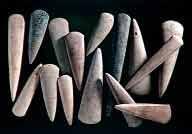- Home
- Discover the megaliths of Morbihan
- Art reflects the sacred
- Prestige objects
Unlike the objects used in daily life, prestige objects, though they were often shaped according to practical models, had no functional use.
The best illustrations of the Neolithic prestige objects in the West of France are certainly the polished pyroxenite 'formal axes'.
These axes combined :
- strong symbolism: the 'formal axe' was certainly an exaggerated representation of the common axe, a vital tool to control and exploit the woodlands,
- aestheticism: the axe was finely shaped and made of a precious and appealing material (shiny, translucent and green, a colour apparently highly appreciated in the Neolithic),
- rarity : the stone used must have come from the far distant Alps,
- spectacular and exceptional size : the formal axe head could be up to 40 cm long, that is more than double the normal size,
- sacrificial use : these objects were to disappear with the exceptional figures who had owned them in the tombs of large carnacean barrows.
Next slide
Previous slide
Polished pyroxenite axe blades, according to a watercolour by L. de Cussé.
These polished pyroxenite axes found in the 19th century in Arzon may have been the rich artefacts of a "carnacean" grave, already destroyed at the time.

